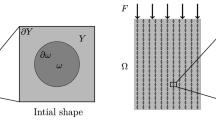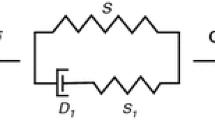Abstract
We study the smoothness properties of the optimal solutions corresponding to the minimization of the potential energy for the mixture of two isotropic materials (electric, thermic, elastic membrane,\(\ldots \)). As it is well known this problem has not solution in general and therefore our results refer to a relaxed formulation. We show that the state function \(u\) is twice derivable and that the optimal proportion is derivable in the direction of \(\nabla u\). We also get some uniqueness results and applications to the non-existence of classical (unrelaxed) solutions.
Similar content being viewed by others
References
Allaire, G.: Shape Optimization by the Homogenization Method. Appl. Math. Sci., vol. 146. Springer, New York (2002)
Briane, M., Casado-Díaz, J.: Uniform convergence of sequences of solutions of two-dimensional linear elliptic equations with unbounded coefficients. J. Differ. Equ. 245, 2038–2054 (2008)
Casado-Díaz, J., Couce-Calvo, J., Martín-Gómez, J.D.: Relaxation of a control problem in the coefficients with a functional of quadratic growth in the gradient. SIAM J. Control Optim. 43, 1428–1457 (2008)
Casado-Díaz, J.: Smoothness properties for the optimal mixture of two isotropic materials. The compliance and eigenvalue problems (to appear)
Franchi, B., Serapioni, R., Serra Cassano, F.: Irregular solutions of linear degenerate elliptic equations. Potential Anal. 9, 201–216 (1998)
Gilbarg, D., Trudinger, N.S.: Elliptic Partial Differential Equations of Second Order. Springer, Berlin (2001)
Goodman, J., Kohn, R.V., Reyna, L.: Numerical study of a relaxed variational problem for optimal design. Comput. Methods Appl. Mech. Eng. 57, 107–127 (1986)
Kawohl, B., Stara, J., Wittum, G.: Analysis and numerical studies of a problem of shape design. Arc. Rational Mech. Anal. 114, 343–363 (1991)
Lions, J.L.: Some Methods in the Mathematical Analysis of Systems and Their Control. Science Press, Beijing (1981)
Lurie, K.A., Cherkaev, A.V.: Exact estimates of the conductivity of a binary mixture of isotropic materials. Proc. R. Soc. Edinburgh 104 A, 21–38 (1986)
Manfredi, J.J.: Weakly monotone functions. J. Geom. Anal. 4, 393–402 (1994)
Murat, F.: Un contre-example pour le problème du contrôle dans les coefficients. C.R.A.S. Sci. Paris A 273, 708–711 (1971)
Murat, F.: Théorèmes de non existence pour des problèmes de contrôle dans les coefficients. C.R.A.S. Sci. Paris A 274, 395–398 (1972)
Murat, F.: H-convergence. Séminaire d’Analyse Fonctionnelle et Numérique, 1977–78, Université d’Alger, multicopied, 34 pp. English translation : Murat, F., Tartar, L.: H-convergence. In: Cherkaev, L., Kohn, R.V. (eds.) Topics in the Mathematical Modelling of Composite Materials. Progress in Nonlinear Diff. Equ. and their Appl., vol. 31, pp. 21–43. Birkaüser, Boston (1998)
Murat, F., Tartar, L.: Calcul des variations et homogénéisation. In: Les méthodes de l’homogénéisation: theorie et applications en physique, pp. 319–369. Eirolles, Paris (1985). English translation : Murat F., Tartar, L.: Calculus of variations and homogenization. In: Cherkaev, L., Kohn R.V. (eds.) Topics in the Mathematical Modelling of Composite Materials. Progress in Nonlinear Diff. Equ. and their Appl., vol. 31, pp. 139–174. Birkaüser, Boston (1998)
Spagnolo, S.: Sulla convergenza di soluzioni di equazioni paraboliche ed ellittiche. Ann. Scuola Norm. Sup. Pisa Cl. Sci. 22, 571–597 (1968)
Stampacchia, G.: Le problème de Dirichlet pour les équations elliptiques du second ordre à coefficients discontinus. Ann. Inst. Fourier, Grenoble 15, 189–258 (1965)
Tartar, L.: Estimations fines de coefficients homogénéisés. In: Kree, P. (ed.) Ennio de Giorgi colloquium. Research Notes in Mathematics, pp. 168–187. Pitman, London (1985)
Tartar, L.: Remarks on optimal design problems. In: Bouchitté, G., Buttazzo, G., Suquet, P. (eds.) Calculus of Variations, Homogenization and Continuum Mechanics. Series on Adv. in Math. for Appl. Sci., vol. 18, pp. 279–296. Word Scientific, Singapore (1994)
Tartar, L.: An introduction to the homogenization method in optimal design. In: Cellina, A., Ornelas, A. (eds.) Optimal Shape Design. Lecture Notes in Mathematics, vol. 1740, pp. 47–156. Springer, Berlin (2000)
Tartar, L.: The general theory of the homogenization. A personalized introduction. Springer, Berlin (2009)
Acknowledgments
This work has been partially supported by the project MTM2011-24457 of the “Ministerio de Economía y Competitividad” of Spain.
Author information
Authors and Affiliations
Corresponding author
Additional information
Communicated by L. Ambrosio.
Rights and permissions
About this article
Cite this article
Casado-Díaz, J. Some smoothness results for the optimal design of a two-composite material which minimizes the energy. Calc. Var. 53, 649–673 (2015). https://doi.org/10.1007/s00526-014-0762-5
Received:
Accepted:
Published:
Issue Date:
DOI: https://doi.org/10.1007/s00526-014-0762-5




